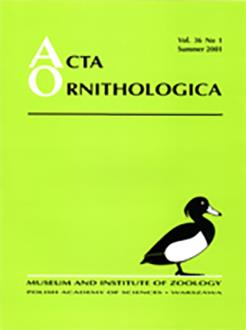The lifetime breeding success of male Pied Flycatchers was evaluated over a period of nine years (1991–99). The breeding success of males recorded in at least two breeding seasons, and nesting at least once in the study area, was analysed. The lifespan number of offspring was positively and significantly correlated with longevity. The reproductive investment in the first year of life did not correspond with longevity, and hence nonbreeding males in the first year did not compensate for the losses in fecundity. There were no differences in longevity between dark, intermediate and female-like coloured males. Darker males were less successful in their breeding attempts in the first year than paler birds. Breeding in the first year of life positively influenced the future number of fledglings, and the greater investment in reproduction in this year positively affected future brood size in dark males. Among males successfully breeding in the study area from their first season, dark males reared significantly more offspring during their lifetime, and in the first year of life, than paler ones. Nevertheless, in the total sample, lifetime brood size did not vary between differently coloured males, perhaps because dark males are more vulnerable to predators. The general difference between differently coloured males lay in how breeding efforts were distributed during life. Dark males can maximise reproductive investment from the first breeding year, while paler males increased average brood size in the following years of life only.
How to translate text using browser tools
1 July 2001
Male Colour Type and Lifetime Breeding Success in the Pied Flycatcher Ficedula hypoleuca
Elena V. Ivankina,
Vladimir G. Grinkov,
Anvar B. Kerimov
R. V. Alatalo
,
A. Lundberg
,
K. Stahlbrandt
1984. Female mate choice in the Pied Flycatcher Ficedula hypoleuca. Behav. Ecol. Sociobiol. 14: 253–261. Google Scholar
N. S. Anorova
1977. [Colour morphs of the Pied Flycatcher males breeding on south Moscow area]. Bull. MOIE Otdel. Biologii 82: 10–18. Google Scholar
N. S. Anorova
1981. [Plumage colour of the Pied Flycatcher males and their offsprings of the same sex]. Bull. MOIE Otdel. Biologii 86: 30–36. Google Scholar
R. Drost
1936. Uber das Brutkield mannlicher Trauerfliegenfanger, Muscicapa hypoleuca. Vogelzug 6: 179–186. Google Scholar
V. M. Gavrilov
1997. Energetics and avian behaviour. Physiology and General Biology Reviews. Harwood Acad. Publ. Google Scholar
V. G. Grinkov
,
A. B. Kerimov
1998. [Reproductive strategies and colour polymorphism in breeding plumage of the male Pied Flycatcher (Ficedula hypoleuca, Muscicapidae, Passeriformes): probable mechanisms maintaining the phenotypic population structure]. Zool. Zhurnal
77
: 825–837. Google Scholar
V. M. Gavrilov
,
A. B. Kerimov
,
E. V. Ivankina
1993. [Population and geographic variation of plumage colour and metabolism in males of different colour type in the Pied Flycatcher]. Doklady Akademii Nauk 333: 608–610. Google Scholar
E. V. Ivankina
T. A. Ilyina
A. B. Kerimov
1995. [The male plumage variability and the strategy of attracting a female: the estimation of the advertising behaviour's spatial organisation in bright and criptically coloured males of Pied Flycatcher (Ficedula hypoleuca, Passeriformes, Aves)]. Zhurnal Obshchey Biologii 56: 762–775. Google Scholar
T. Järvi
,
E. Røskaft
,
M. Bakken
,
B. Zumsteg
1987. Evolution of variation in male secondary sexual characteristics. A test of eight hypotheses applied to pied flycatcher. Behav. Ecol. Sociobiol. 20: 161–169. Google Scholar
A. B. Kerimov
,
E. V. Ivankina
1999. The relation between resting metabolic rate of fledglings and father's colour type in the Pied Flycatcher (Ficedula hypoleuca). Ring 21: 203. Google Scholar
A. B. Kerimov
,
E. V. Ivankina
,
V. S. Shishkin
1995. [Unstable sexual dimorphism and reproductive rates in the Pied Flycatcher]. Ornitologiya 26: 13–27. Google Scholar
J. T. Lifjeld
,
T. Slagsvold
1988. Female Pied Flycatcher Ficedula hypoleuca choose male characteristics in homogeneous habitats. Behav. Ecol. Sociobiol. 22: 27–36. Google Scholar
J. Potti
,
S. Montalvo
1991. Return rate, age at first breeding and natal dispersal of Pied Flycatchers Ficedula hypoleuca in central Spain. Ardea 79: 419–428. Google Scholar
E. Røskäft
,
T. Jarvi
,
N. E. I. Nyholm
,
M. Virolainen
,
W. Winkel
,
H. Zang
1986. Geographic variation in secondary sexual plumage colour characteristics of the male Pied Flycatcher. Ornis Scand. 17: 293–298. Google Scholar
G.-P. Saetre
1993. Sex recognition by male Pied Flycatchers in a population with little sexual dimorphism in plumage colour. Ornis Scand. 24: 158–160. Google Scholar
G.-P. Saetre
,
S. Dale
,
T. Slagsvold
1994. Female Pied Flycatcher prefer brightly coloured males. Anim. Behav. 48:1407–1416. Google Scholar
G.-P. Saetre
,
T. Fossnes
,
T. Slagsvold
1995. Food provisioning in the Pied Flycatcher: Do females gain direct benefits from choosing bright-coloured males? J. Anim. Ecol. 64: 21–30. Google Scholar
T. Slagsvold
,
J. T. Lifjeld
1988. Plumage colour and sexual selection in the Pied Flycatcher Ficedula hypoleuca. Anim. Behav. 36: 395–407. Google Scholar
T. Slagsvold
,
J. T. Lifjeld
1992. Plumage colour is a conditiondependent sexual trait in male Pied Flycatcher. Evolution 46: 825–828. Google Scholar
T. Slagsvold
,
G.-P. Saetre
1991. Evolution of plumage colour in male Pied Flycatchers (Ficedula hypoleuca): evidence for female mimicry. Evolution 45: 910–917. Google Scholar
V. G. Vysotsky
1995. [Plumage colour of the male Pied Flycatcher Ficedula hypoleuca and its connection with other characteristics]. Ornitologiya 26: 28–32. Google Scholar

Acta Ornithologica
Vol. 36 • No. 1
July 2001
Vol. 36 • No. 1
July 2001
breeding strategies,
Ficedula hypoleuca
lifetime reproductive success
Pied Flycatcher




